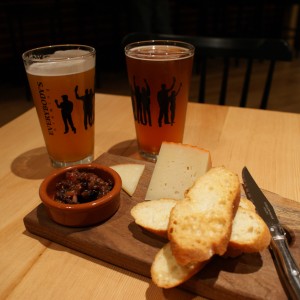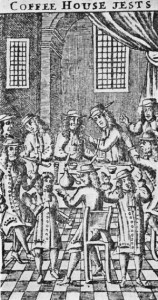When I lived in Madrid in college, I read several guidebook descriptions of Café Gijón and knew I had to go. I wasn’t sure if I was going to be a writer, but I sure liked the idea of being a writer, and a “famous literary café” with artists and writers still meeting up to drink and philosophize sounded like somewhere I needed to be.
I showed up one winter afternoon, ordered a coffee in my shy Spanish, and waited. When nothing happened but the arrival of my coffee, I didn’t know what to do, so I pulled out a notebook and began to write.
What happened next might be a little blurred by years and vino tinto, but suddenly there was a balding man sitting across from me holding out a tiny glass of sherry. I found myself trying to tell him about the one philosophically-oriented book I’d read recently, The Quantum Society, but I got mixed up somewhere between the particles and the waves.
Whatever I said must have sounded as bad as that does, because he said, “You’re not very articulate. But you’re still very young. Why don’t you come sit with my friends?”
I started thinking about this night when I was sitting in a bar a few weeks ago at a table of strangers. The occasion was a science pub night, part of a monthly series of talks put on by our town’s natural history museum.
Before I went, I figured the attendees would be a small, older crowd—you know, museum donors, retirees, volunteer docents. But the bar tables were packed, even the pool tables had been turned into beer-friendly surfaces, and my table had a range of ages and backgrounds—an accountant, a university employee, some guys from a local software company.
Alison Pischedda, the UCSB post-doc who gave the talk, started out the night by saying that there’d be a fair amount of sex and sperm in her talk, billed as “Sperm Wars and Sexual Conflict”—“so if that makes you uncomfortable, you might want to get another beer.” And the photos and videos she showed–like one of a hermaphroditic flatworm sucking undesirable sperm out after a round in a flatworm mating ring—set off slightly boozy laughter.
But at the end of the talk, people asked questions about the proteins in Drosophila semen that can affect female behavior. They asked how female eggs might be evolving, about the logistics of conducting experiments with fruit flies, about the problem of anthropomorphizing when part of your research is about sex.
***
Years ago in Café Gijón, I sat around a table with a group of writers, straining to understand as they argued and interrupted each other and ordered more wine and coffee. Since then, I’ve often wished that gatherings like these were a more regular part of my life. I’ve wondered what it would have been like to step into a English coffeehouse in its heyday. I might have watched Sir Isaac Newton and Edmund Halley dissect a dolphin right inside The Grecian, or hear sailors and scientists learn from each other at The Marine. (Of course, I probably would have needed to attend disguised as a man, but since this is my daydream and not day-to-day reality, the intrigue adds to the appeal.)
For Pischedda, the appeal of doing an informal talk like the one I went to is the chance to return to the questions that originally hooked her into evolutionary biology. “When you study fruit flies, like I do, people don’t always get why you’re doing that,” she said. Talks like this can help people understand more about what she’s investigating.
I only went to Café Gijón that once. I think I didn’t want to go back until I could offer something too, until I could argue and interrupt and order more wine and coffee. And now that I think about it, all the learning and talking and reading and writing I’ve done since has, on some level, been a way of readying myself to return.
Maybe someday someone will read in a guidebook that Dargan’s, in downtown Santa Barbara, is one of the famous places where people gather to discuss science. A wide-eyed coed, or a visiting retiree, or a barista, or a tax lawyer will wander in, have a drink, see a world that she hasn’t seen before. At the least, she’ll go away armed with the incredible fact that a barnacle’s penis is 40 times the size of its body. But maybe she’ll also imagine that some day, she’ll have something to contribute, too.
Find a science pub near you:
Science Cafés
***
Images Top: Amanda Erickson. Middle: Not Exactly Rocket Science. Bottom: A woodcut of a 17th century English coffeehouse.


Cam,
I am amazed at how you are able to integrate so many different insights in a short piece. You have a wonderful ability to comprehend a scene and express it so beautifully – even if you only visited the cafe one time.
Keep it up!
Karl
Cameron,
What an insightful article…who knew a cafe would so enhance your pursuit of science? I’ll never look at a barnacle quite the same…
Engaging!
love, Sue